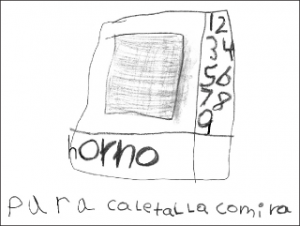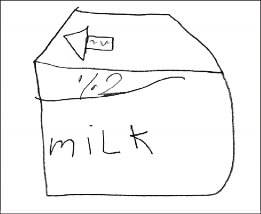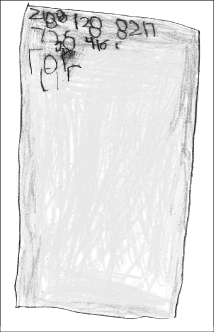Numbers at School
 All Classroom Lessons
All Classroom Lessons

A Lesson for Kindergartners
by Chris Confer
In this lesson, excerpted from Chris Confer’s new book Teaching Number Sense, Kindergarten (Math Solutions Publications, 2005), children learn that numbers are used for different purposes. They search for numbers in their school, draw pictures of things that have numbers, discuss how numbers help people, as well as talk to adults in their building about how they use numbers.
“We’re going to take a walk today,” I told the children, “and we’re going to look for numbers and think about how those numbers help people. Why are numbers important at school and in our homes?”
“I’ve got numbers at my house,” Ricardo said. “We’ve got a clock so my mom can be on time.”
“My mom uses numbers to cook,” Pradnya said.
“Does your mom use a measuring cup?” I asked.
Pradnya nodded.“It measures,” Rafael offered. “You can put flour or sugar in it so you know how much.”
“I wonder what numbers we have in our school,” I said to introduce the investigation. “How does Ms. Martínez, the principal, use numbers? And I wonder how the nurse uses numbers. We’re going to take a walk around the school to look for numbers. When you see a number, think about why that number is there. And then I want you to sketch the thing that has the numbers and think about how those numbers help people.”
We lined up, and the students clutched blank paper on clipboards and pencils. As we walked out the door, they immediately noticed the door number. They copied it down, and I reminded them that I wanted them to draw the whole door as well as its number. As we walked down the hall, they stopped by the fire extinguisher.
“I see numbers,” Ana said.
We looked closely and saw that Ana was right; there were dates recording when the fire extinguisher was tested.
The children saw numbers all along the walls in classroom displays. Two children copied a chart of counting by tens, and another looked at a recipe for “Good‐Smelling Play‐Doh.”
I moved the children on to the nurse’s office. “Do you have any numbers in here?” Marco asked. Ms. Gonzales showed the students the electronic thermometer. She took Marco’s temperature and the children counted as the thermometer registered higher and higher numbers until it stopped at 99.
The students then gathered around a t all plastic device for measuring height. “It’s got a lot of numbers!” Lina exclaimed. Some children sketched it while others noticed the numbers on a chart for testing eye sight. Amanda, Gabriela, and Rafael gathered around the microwave to sketch it while explaining to each other what the numbers did. (See Figure 1.)

Figure 1. Gabriela’s drawing showed the
numbers on the microwave and included
her explanation, “El horno es para calentar
la comida” (The microwave oven is for
heating food).
“I
had
no
idea
that
we
have
so
many
numbers
in
here!”
Ms.
Gonzales
exclaimed.
We
stopped
in
the
cafeteria,
where
the
kitchen
helpers
were
cleaning
up
after
lunch.
“What
numbers
do
you
have?”
asked
Ana.
“We have to count just about everything in the kitchen, and we write the numbers on report forms,” Mrs. Miranda said. “We count the trays before lunch and after lunch so we can find out how many children ate today. We count the cartons of milk before breakfast and after breakfast for the same reason. Every Friday we count the forks and the spoons and compare the numbers with last Friday to see how many got lost. “The children nodded and began to sketch. (See Figure 2.)

Figure 2. Amanda found a number 2 on
a carton of milk.
“Look at the dishwasher,” Mrs. Miranda said. “It says ‘one hundred fifty.’ Why do you think that number is there?”
“It tells how many trays are in it?” Ana asked.
“Actually, it tells how hot the water is as the dishes are being washed,” Mrs. Miranda answered. “It has to get to one hundred and fifty degrees during the wash cycle and one hundred and seventy degrees during the rinse. That’s how the germs are killed so you don’t get sick.”
“The lunch lady asks us our number when we come to eat,” Verena reminded Mrs. Miranda.
“That’s
right,”
Mrs.
Miranda
answered.
Verena was
referring
to
the
number
assigned
to
children
who
qualify
for
free
or
reduced‐cost
lunch;
the
cashier
circles
the number
when
a
child
goes
through
the
check out
line.
Nearly
all
the
students
at
my
school
qualify
for
the
lunch
program,
so
Mrs.
Miranda’s
list
has
about
three
hundred
numbers
on
it.
(See
Figure
3.)

Figure 3. Andrés copied the list of numbers
that are assigned to students in the free lunch program.
“Let’s look at my list of numbers,” suggested Mrs. Miranda. “Why do you think we ask you your number instead of your name?” she asked.
“’Cause it’s fast?” Marisa asked.
“Right,” Mrs. Miranda said. “And after lunch we count the numbers. Look how we circle the groups of ten. Then we count ten, twenty, thirty, forty, fifty, and so on until we find out how many children ate today. That number has to match the number of trays.”
The children noticed the numbers that showed the price of the lunches. Mrs. Miranda then showed them the long cash‐register tape that showed all the lunches that were bought that day.
“The next thing Ms. Hanson and I do is count all the money. The money has to match this number at the bottom,” Mrs. Miranda explained.
Ms. Hanson joined us then. “ How many of you ate pizza pockets today?” she asked. Eleven children raised their hands.
“And how many of you ate tacos?” The others’ hands went up.
“This morning,” Ms. Hanson explained, “I used your lunch counts to figure out how many we’d need for the whole school, and I had to count how many pizza pockets to make and how many tacos.”
When we returned to our classroom after the twenty‐minute walk, the children gathered on the rug with their drawings.
“What did you discover?” I asked them. “As you tell us how people at our school use numbers, I’ll write down what you say. Later we’ll put the chart in the hall to share our discoveries with everyone else.”
“There’s numbers on all the doors,” Pradnya said.
I recorded her observation and then inquired, “Why are they there?”
“So your mom knows which is your room,” answered Robert.
“The calendar number says the day,” Ana said.
“That’s true,” I answered as I wrote her words on the chart.
“The nurse uses that tall thing to tell you how big you are,” Graciela contributed.
“What other things does the nurse measure?” I asked.
“How much we weigh,” Marisa said.
“And our temperature,” Ana added.
“Do they use numbers to measure things in the cafeteria?” I inquired.
The children chattered about all the measuring they had seen in the lunchroom.
We continued discussing while I wrote their observations on the chart. When we were finished, we reread the chart together:
Numbers in Our School
The doors have numbers.
The calendar number says the day.
The nurse measures how tall we are and how much we weigh.
Marco’s temperature is 99 degrees.
We tell Mrs. Miranda our lunch numbers.
The lunch ladies count the trays and the milk cartons.
The dishwasher has 150 on it.
We saw the lunch price.
They count the tacos.
“You made some wonderful drawings of all the things that we found that have numbers,” I said. “Would you mind contributing some of your illustrations to our chart?”
Children volunteered to add their pictures to illustrate various observations and went to get scissors and glue sticks. Soon the chart was ready.
Then we re read our words and admired our illustrations. Before I taped the chart to the hallway wall, I said, “It will be nice for Mrs. Miranda and Ms. Gonzales to see all that we learned from them. And maybe the other children at school will start noticing numbers, too.” It was clear that the students had a new awareness of the importance of numbers in the world around them.

Comments